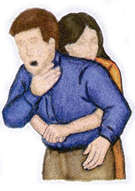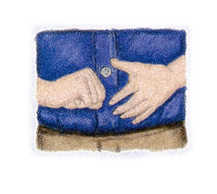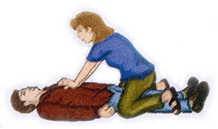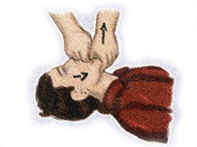1.- En caso de ahogo:
1.- Pregunte si la persona se está ahogando.
1.-Ask if the person is suffocating. If the person is tosiendo strongly and can breathe, do not interfere, wait, and do that the person continues tosiendo. If the person cannot answer, call to the medical service of emergency. Go to the step N ° 2.
|
2.- Posicione sus manos.
form a fist. Surround the person for the back and place the thumb towards the way of the abdomen of the person (it arrives of the navel and under the top of the thorax). Press the fist with the hand.
|  |
 | 3.- Dé algunas compresiones abdominales.
Press the fist with rapid compressions in the abdomen. (5 times) Continue until the person expels the object and starts breathing or if it loses the conscience:
| |
| 4.- Llame a su servicio médico de emergencia. Si no hay nadie todavía: 5.- Acueste a la persona boca arriba
|
6.- Comience el rescate respiratorio.
It extends the head backward and raise the chin. Press and close the nose Seal his lips about the mouth. Give 2 complete exhalations. If the exhalations do not go inward.
7.- Vuelva a levantar la cabeza e inténtelo de nuevo.
Move the head backward. Close the nose, seal his lips about the mouth and try it again to give 2 exhalations. If the respites still do not enter.
|
8.- Dé compresiones abdominales.
There be mounted on the legs of the person Ponga the palm of his hand in the middle of the abdomen, I joust above of the navel and under the top of the thorax. Put another hand and the tops of the fingers towards the head of the person. Give from 6 to 10 rapid compressions ahead and below.
|  |
9.- Barrido del objeto.
Press the language against the jawbone. If it sees the object and can reach it, sweep it towards out. If the person still does not breathe.
|  |
10.- Regrese al paso N° 6.
Repeat the sequence until the person begins to toser or to breathe.
2. En caso de esguince
Lo primero que debes hacer es tranquilizar al paciente, especialmente si es un niño pequeño, luego debes inmovilizar la parte afectada, pidiéndole que deje de moverla o apoyarla. La articulación lastimada no debe cargar ningún peso. Aplica paños de agua a temperatura ambiente para que se enfríe la zona y haz que la zona se mantenga elevada ligeramente. Antes de aplicar algún vendaje o ungüento, lo mejor es que consultes al médico. Tampoco dejes que ingiera ningún medicamento contra la inflamación o el dolor. Esa decisión debes dejarla en manos de tu médico de confianza.Cuanto antes acudas con el especialista, menos dolor sufrirá la persona afectada.
The first thing that you must do is to calm the patient, specially if he is a small child, then you must immobilize the affected part, asking him to stop moving her or to support her. The injured joint must not load any weight. It applies water cloths to temperature environment in order that the zone is cooled and do that the zone is kept high lightly. Before applying some bandage or salve, the better thing is that you consult the doctor. Neither allow that it should consume any medicine against the inflammation or the pain. This decision you must leave her in hands of your doctor of confidence. As soon as possible come with the specialist, fewer pain the affected person will suffer.
3. En caso de diarrea
Tomar medicamentos para detener la diarrea puede ser útil en ciertos casos, es importante beber mucha agua, pero también debe tomar líquidos que contienen sodio, cloruro y potasio.
To take medicines to stop the diarrhea can be useful in certain cases, it is important to drink great water, but also it must take liquids that contain sodium, chloride and potassium.
4. Si me encuentro con un accidente de tráfico
Llamar a emergencias y a la policía, ya que si intentamos ayudar nosotros podermos causar más daños. Pero lo importante en caso de accidente de moto es nunca quitarle el casco
To call emergencies and the police, since if we try to help podermos to cause more hurts. But the important thing in case of accident of motorcycle is never to take the hull from him
5. Infarto cardíaco
Try that the person feels, rest and try to support the calmness. Any exact cloth slackens. Ask him if it takes medicines for the thoracic pain for a cardiac known disease, as nitroglycerine, and help him to take it. If the pain does not disappear rapidly with the rest or after three minutes after having taken the nitroglycerine, request medical urgent help. If the person is incosciente and does not react, call to the local number of emergencies (911 in the United States) and then the RCP initiate If a baby or a child is unconscious and does not react, administer the RCP during a minute and then call to the number of emergencies (911).
|

good job cris, but if you put all in the same letter it is better.
ResponderEliminarhelp to people is important good information,but the words are so small....
ResponderEliminar